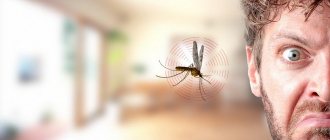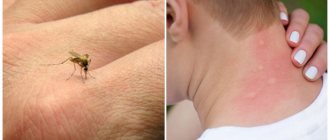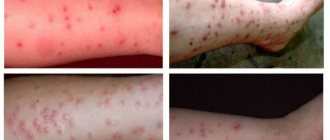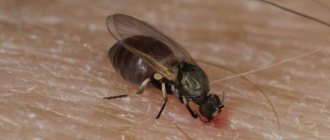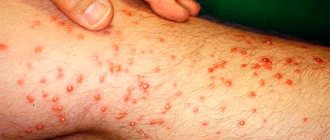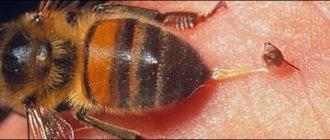Danger of insect bites
Most species of insects living on the planet do not pose a threat to the human body.
However, the bites of some creatures can lead to negative manifestations. The greatest danger to humans is posed by poisonous species and some ants.
Most often, poisonous insects encounter humans while defending themselves. Flying parasites can also cause harm. These are some flies, gadflies, mosquitoes, etc. When the skin is damaged by their stings, a toxin enters the bloodstream, which can cause allergies.
What insect bites are dangerous?
The insects that most annoy humans in Russia are:
- Household insects: bedbugs, fleas, lice, flies, cockroaches. These are carriers of viruses, bacteria, diphtheria, helminth eggs, plague, and typhoid.
- Gnus: mosquitoes, midges, midges, midges, horse flies. These blood-sucking insects carry dangerous diseases (encephalitis, malaria, onchocerciasis) and can cause allergies.
- Hymenoptera: wasps, bees, bumblebees. The bite is painful. The sting of these insects contains active biological substances, which, when entering the human body, can cause an allergic reaction and even anaphylactic shock. In particular, you need to beware of the hornet: its bites sometimes cause severe intoxication of the body, and an attack by several insects in rare cases leads to death.
- Arachnids: ticks and spiders. Arthropods, but not insects in the scientific sense. The tick is the most dangerous species of blood-sucking animal in Russia. The consequences of a tick bite and suction to the skin can be tick-borne encephalitis and borreliosis (Lyme disease). There are few poisonous spiders in the Russian Federation, but they do exist. The bites of some spiders are dangerous and painful for humans: the web spider, the South Russian tarantula, the false black widow, etc.
Symptoms of an insect bite
The nature of the manifestations resulting from the bite depends on the type of insect. General signs:
- hematomas, bruises and bumps in the damaged area;
- pain;
- redness;
- burning and itching.
Do not scratch the bitten area, otherwise infection may enter the wound.
Swelling
It often happens that after an insect bite, the leg, arm and other parts of the body become swollen. The severity and localization of swelling depends on the type of pest and the location of the damage. In most cases, swelling from a bite goes away on its own within a few hours. If your leg or any other part is swollen and the swelling does not subside, you should immediately consult a doctor.
Itching and redness
Most often, itching and redness appear after bites of bedbugs, fleas and mosquitoes. To relieve discomfort, you can use pharmacy or folk remedies.
Pain
Painful sensations appear when stung by bees, spiders, scorpions and poisonous creatures. In some situations, pain occurs only a few minutes after the injury.
Hyperemia
This condition is accompanied by redness of the damaged epidermis. Hyperemia accompanies any bites. It can only differ in severity and duration.
Allergy to insect bites
In most situations, parasite bites provoke the development of an allergic reaction. Main symptoms:
- painful sensations;
- swelling;
- red spots near the affected area;
- itching;
- increase in local temperature.
Most often, allergies do not require specific therapeutic measures. But in some situations, allergies are accompanied by more severe symptoms:
- stress;
- increased heart rate;
- problems with respiratory function;
- swelling of the larynx and face;
- dizziness;
- a sharp decrease in blood pressure;
- severe itching;
- skin rashes.
If you have these manifestations, you should definitely go to the hospital.
Particular care should be taken if the tumor begins to grow rapidly after an insect bite.
Treatment
What to do if your leg is swollen after an insect bite? Therapy depends on what consequences the patient has and who exactly bit the person.
Medicines
The prescription of medications depends on the troubling symptoms. The most commonly used ointments and creams are:
- Relieves pain.
- Suppress the inflammatory process.
- Eliminate swelling.
Painkillers and anti-inflammatory medications help treat a bite. To prevent the development of allergies due to insect bites, antihistamines are used. Sometimes hormonal drugs are used, but subject to the doctor's approval.
Removing the sting
This method is suitable in cases where a bee or wasp stings. If your leg is swollen from the bite of one of these insects, you should first remove the sting with a needle or tweezers. The instrument must first be sterilized with alcohol to avoid introducing infection into the blood.
When removing, you need to act carefully so as not to break the insect's sting and not leave it inside the cover. It is removed without problems (it does not hurt). If the sting remains inside, you should consult a doctor to remove the foreign object.
How to determine who bitten by footprints
The bites of different types of insects have their own characteristics. They have different external manifestations, signs and consequences.
Bedbugs and linen lice
In most situations, bed bugs leave bites on the human body. These insects are active at night when a person is sleeping. In the first time after damage, practically no signs are visible on the skin. In rare cases, small red spots appear on the dermis. After 24 hours, redness and swelling occur in the affected area. Research results have shown that these creatures may be carriers of Chagas disease.
Body lice (linen lice) bite in much the same way as bedbugs. Such a bite can lead to lice.
Spiders
Most of these representatives of the order Arthropods are non-poisonous. The bites of such creatures are accompanied only by itching and redness. However, in nature there are spiders whose bites provoke severe allergies in the human body. This condition can lead to severe intoxication or skin necrosis.
The most dangerous spider is the black widow spider. The first negative manifestations after contact with this species of arthropod occur within 20-30 minutes. The victim experiences pain and swelling. After 2-3 hours, aches and pains appear in his body, vomiting and nausea develop.
Ticks and fleas
Most often, people become victims of this insect while walking in the forest. Ticks move deftly throughout the human body, so they often leave bites in hard-to-reach places:
- armpits;
- peritoneum;
- groin area;
- skin behind the ears;
- neck.
In this case, the person may not feel any effect on the affected area. Signs of a bite:
- tachycardia;
- headache;
- feeling of weakness.
In addition, ticks are carriers of a large number of diseases. They can cause the development of:
- hemorrhagic fever;
- Lyme disease;
- encephalitis.
There are mites that live under human skin. They are called demodexes and can cause the development of a pathology such as demodicosis.
After flea bites, small reddish dots first appear on the skin, accompanied by moderate itching. Most often, fleas affect the following places:
- peritoneum;
- armpits;
- calf muscles;
- knee area;
- ankles.
An allergy to flea bites is manifested by itching, swelling and redness of the epidermis. Previously, these insects were carriers of plague.
Bees, mosquitoes and midges
Midge and mosquito bites are accompanied by itching and mild swelling. In most cases, discomfort goes away within 1-2 days.
A bee sting is accompanied by severe and immediate pain that can last up to 3-4 hours. The stung area becomes pale in the center, and redness appears around the sting point. In addition, such damage leads to severe swelling. If you are bitten several times, a severe allergy may develop. It is accompanied by the following manifestations:
- feeling of weakness;
- angioedema;
- convulsive conditions;
- dizziness;
- heart rhythm disturbance;
- complete stop of the heart muscle (in case of multiple bites).
Scorpios
As a result of such a bite, the victim immediately experiences pain and burning. Symptoms may vary depending on the type of scorpion. General manifestations:
- swelling;
- pain;
- burning;
- numbness;
- paleness of the skin;
- tachycardia;
- nausea;
- limb spasms;
- redness.
Pharmacy products
If itching appears, the hand swells after a mosquito bite, go to the pharmacy for medicinal drugs. You can buy ointments and many tablets without a prescription.
Ointment
Ointment is the most popular remedy for insect bites. Children often refuse to take pills, and treating the skin with ointment is not difficult.
Fenistil-gel
The gel contains a light insecticidal agent. It has an antihistamine, antiallergic effect, a person gets rid of itching after a bite. Recommended for use if the skin turns red, itches, swelling, or hardening occurs. A thin layer is applied to the skin three times a day. The itching disappears within a few minutes, swelling after a mosquito bite and redness can be relieved after 24 hours.
Psilo-balm
It has antiallergic properties and blocks the action of histamine, which causes itching. Rub into the skin 3-4 times a day. After 5 minutes, the gel is absorbed, the itching goes away instantly. The product cools the skin and soothes irritation resulting from the bite.
Levomekol for inflammation and swelling
The ointment contains:
- methyluracil, used for mosquito bites as an immunomodulator;
- chloramphenicol, which has an antimicrobial effect.
Treatment with the drug prevents further development of the tumor and relieves the resulting redness and swelling. If a child over 3 years of age has a swollen arm or leg after an insect bite, apply the ointment to the affected area for a week until the symptoms disappear.
Soventol for allergic reactions
If after a bite not only swelling and redness appear, but also other signs of allergy, use Soventol. It prevents the production of histamine, resulting in the formation of edema, and is safe for children over 3 years of age.
If a child with allergies has a large part of their leg swollen after a mosquito bite, then use Soventol, but do not forget to read the instructions to understand what to do with the affected area so as not to harm the baby.
Edema rescuer
Another drug based on herbal ingredients, which effectively relieves swelling, eliminates pain and promotes rapid healing of wounds.
If you are racking your brains trying to figure out what to apply to a mosquito bite on an infant in order to relieve the symptoms that have arisen, then feel free to use Rescuer, which:
- contains sea buckthorn oil, which relieves pain;
- quickly removes swelling and swelling;
- Suitable for children of any age.
Nezulin
The cream-gel contains natural ingredients. To prepare the extract, use:
- chamomile;
- celandine;
- plantain;
- licorice.
Essential oils are extracted from basil, mint, and lavender. The most effective way to remove redness is after the first use. Itching is blocked for a short time. It repels other mosquitoes with a specific smell.
Elidel
This is a non-hormonal anti-inflammatory drug. It does not act immediately, but only after some time after rubbing, when the inflammatory process begins to decrease.
This cream can be used to treat bites in children who are already 3 months old.
The product cannot be used for a long time and constantly, but in the case of insect bites, this, fortunately, is not required. It can be applied twice a day with a break of 12 hours.
Cycloderm
To relieve swelling after a mosquito bite, apply the ointment evenly to the affected areas. Apply up to 6 times a day. It also relieves redness caused by insect bites.
Flucinar for swelling
If the hand is very swollen from an insect bite, and the child complains of unbearable itching, use Flucinar. The active substance (fluocinolone) effectively fights swelling, eliminates allergic swelling and reactions. To help an injured child, apply a thin layer of gel to the affected area in the morning and evening.
The drug is not suitable for children under 2 years of age and patients with viral, bacterial or fungal infections of the skin.
Hydrocortisone ointment
Local anti-inflammatory agent, available in 0.5 or 1 percent. Used to suppress redness and swelling after insect bites. Prevents inflammation, removes swelling and itching.
First aid
If the negative symptoms are severe, the victim should immediately call an ambulance. Before the doctors arrive, you need to do the following:
- thoroughly rinse the bite area with running water and laundry soap;
- apply an anti-inflammatory drug to the skin;
- avoid scratching the bite;
- minimize swelling by applying cold to the damaged area;
- treat the bitten area with an antihistamine (Fenistil, etc.);
- Give the victim antihistamines (for example, Suprastin).
Most often, complications can be prevented. However, if you have an allergic reaction, you cannot do without medical help.
If a tick is found under the skin, you should immediately contact a surgeon so that he can remove the parasite in the most effective and safe way. If you cannot see a doctor, you will have to perform the procedure yourself. For this purpose, you need to use small forceps.
The affected area should be treated with a good antiseptic: iodine, chlorhexidine, alcohol or hydrogen peroxide.
The insect removed from the skin must be placed in an airtight glass container. It must be taken to the laboratory for testing within 2-3 days.
If the victim experiences anaphylactic reactions, the following should be done:
- First you need to call an ambulance.
- The victim needs to take a horizontal position and slightly raise his lower limbs.
- After this, you need to apply something cold to the affected area of the skin.
- If the victim loses consciousness, his respiratory function must be carefully monitored. When it stops, emergency resuscitation measures should be carried out (artificial respiration, cardiac massage, etc.).
- If the victim is in a conscious state, he needs to be given antihistamine medications (Tavegil, Suprastin, etc.). Additionally, an injection of Epinephrine should be given in a dosage of 0.1 to 0.3 ml.
- In case of severe pain, you need to take painkillers.
The visiting medical specialists need to tell you as much as possible about what happened. After this, the victim is taken to the hospital and undergoes a thorough diagnosis to identify the cause of the condition and select the optimal method of therapy.
Help for the victim
When or other part of your body is swollen after an insect bite, This helps to partially eliminate the parasite's saliva from the surface of the integument. Next, you need to act according to the plan depending on the severity of the condition:
- If the swelling is not severe, then apply cold for 5-10 minutes. To do this, ice is wrapped in thin cloth. This helps stop the spread of poison. When there is no cold nearby, you just need to firmly press the wound with your finger.
- When the swelling rapidly increases, it is necessary to apply a tourniquet above the bite area.
- The penetration site must be treated with Miramistin, Chlorhexidine, and Betadine solution.
- Next, make a soda compress. To do this, several spoons of powder are mixed with a small amount of water. The resulting pulp is spread on a bandage and applied to the bite. You can keep the compress for 20-30 minutes.
- Antihistamines are used both topically and as oral medications. In severe conditions, injections of antiallergenic drugs are indicated. The most common are Tavegil, Suprastin, Erius, Cetrin.
If serious complications are observed, for example, a sore forms on the leg after an insect bite or the patient loses consciousness or convulses, then urgent medical attention is required.
Help with insect allergies
Depending on the condition, the medical institution may prescribe:
- Compresses with Dimexide 20% (dilute with water). This drug helps eliminate swelling and quickly transports beneficial substances from medications to internal tissues. It is used in conjunction with Suprastin and Tavegil. This helps eliminate allergic manifestations. If Dimexide is applied with Hydrocortisone and Dexamethasone, this will reduce swelling and redness.
- An injection with Diclofenac will relieve inflammation.
- Analgesics: Baralgin, Analgin.
- Anti-inflammatory drugs: Ibufen, Ibuprofen, Nurofen.
- For severe swelling, hormone injections are given: Dexamethasone, Prednisolone.
- If the reaction is not strong, then local hormonal ointments are selected for insect bites with swelling and tissue redness: Lokoid, Advantan, Elokom.
- Antibiotics are indicated if there is a bacterial infection. Levomekol, Oflocain, Triderm are prescribed as ointments. In severe cases, medications for internal use are used: Cefodox, Azithromycin, Amoxicillin.
External remedies for insect bites
For minor redness and swelling, it is enough to apply ice to the problem area. In other situations, you need to use special gels, creams and ointments. Such external remedies after bites have an anti-inflammatory and antihistamine effect. They are used to eliminate negative signs after damage to the epidermis and toxin entering its structure.
For moderate swelling and hyperemia, you can use over-the-counter medications. The antihistamine composition in the form of an ointment is applied directly to the wound. Antipruritic medications should be applied around the problem area.
The most effective drugs:
- Psilo-balm.
- Elidel.
- Calamine.
- Afloderm.
- Bepanten.
- Fenistil.
External products should be used in accordance with the instructions.
Itching and swelling from a midge bite: how to treat it?
Priority assistance measures should be taken to prevent the development of dangerous symptoms.
- Folk remedies can be quite effective for local swelling and itching - a consequence of a midge or mosquito bite. You can find information about how to treat varicose veins using natural remedies and folk recipes here.
- With an increase in temperature, allergic and other alarming symptoms, more serious measures are required, from topical medications to antibiotics and even even resuscitation for anaphylactic shock - one of the most critical consequences.
First aid, prevention of symptoms
An integrated approach is needed, with the goal of blocking all links in the chain of development of pathogenesis, and therefore the ability to avoid complications.
Washing with water and soap. This should always be done without fail. The procedure will remove toxic substances from the wound.
When washing, you can also use laundry soap.
- Do not rub the affected area during or after the procedure to avoid further spread of toxins.
- Apply any antiseptic. Disinfect the affected area using, for example: Furacilin, Miramistin, Chlorhexidine.
- Take one of the antihistamines: Claritin, Diazolin, Fenistil-gel.
- For severe itching, the following will help: Loratadine, Cyterizine or Suprastin, Cetrin, Claritin, Zyrtec. They will reduce the amount of swelling and prevent spread.
- Hormonal drugs: Hydrocortisone ointment, others will prevent inflammatory processes.
- If necessary, you can take a painkiller, for example, Paracetamol. Essential oils diluted in vegetable oil will also help relieve pain.
How to relieve swelling
For local swelling
It is possible to use one of the methods suggested below, or alternate.
1. Application of ice
If swelling appears: apply ice for 10-15 minutes.
2. Pressing down swollen areas
Press a piece of ice or other object directly onto the affected area.
For widespread swelling, you can use an elastic bandage.
3. Lotions
Apply wipes soaked in solutions:
- Semi-alcohol.
- Solev.
- Soda. Baking soda: 1 tsp. for 1 glass of water.
4. Ointments, gels
Topically apply:
- Hormonal ointments that relieve swelling: Hydrocortisone, Triderm.
- Antiallergic : Fenistil, Cynovit
5. Ammonia or boric alcohol
Lubricate the problem area and the surrounding area with ammonia. It will help neutralize the poison.
Also helps with mosquito bites.
Can be used when helping children.
General swelling
In such circumstances, it is better to seek medical help.
Typically used:
1. Antihistamines
The above, as well as:
- L-cet
- Tavegil
- Loratadine
Application is possible in the form of injections or tablets.
2. Glucocorticoids
- Dexamethasone
- Methylprednisolone
- Hydrocortisone
3. Decongestants
- L-lysine aescinate
- Furosemide
Attention! If symptoms increase intensively, swelling spreads to the neck area, respiratory organs, medical attention is immediately needed. Otherwise, the victim’s condition is fraught with death.
Treatment with tablets
Not in all cases, medications in the form of ointments and gels show high effectiveness in eliminating the negative consequences of bee, wasp and other insect bites.
To increase their medicinal effect, you can additionally use oral medications (Benadryl, Diphenhydramine, etc.). In addition, in case of severe inflammation, it is necessary to additionally use antimicrobial medications in tablet form. Severe manifestations require injections of the drug Epinephrine.
General recommendations
Insect bites are most troublesome for allergy sufferers because they experience an allergic reaction and the itching does not go away for several weeks. But this can affect all people.
To facilitate the process you need:
- Treat the bite area with ammonia.
- Wipe the sore spot with vinegar, diluted with soda, vodka and lemon juice.
- Take an allergy medicine.
- Use an ointment with a cooling effect.
- Consult a doctor if swelling does not go away.
Folk remedies after insect bites
There are many home recipes that can be used to eliminate the negative consequences resulting from a bite. Their advantages are availability and high efficiency.
Garlic
This product is in any kitchen. With its help you can quickly get rid of swelling and redness. To do this, prepare a garlic-water tincture from 2 crushed heads and 250 ml of clean water. The mixture is applied to gauze or a bandage, which is placed on the bitten area. Garlic tincture is particularly effective in eliminating itching and swelling after bites of midges, horse flies and mosquitoes.
In addition to the tincture, you can use a gruel made from 1 garlic clove. To do this, the mixture must be placed on the skin and covered with a bandage. The gruel helps with bee and wasp stings. In case of suppuration of the wound, the garlic composition can be mixed with honey in the same ratio. However, this technique is not suitable for allergy sufferers and those with sensitive skin, because... Garlic can cause severe burns.
Cabbage
Cabbage leaves help quickly get rid of compaction and swelling in the bite area. To do this, they need to be cut into strips and scalded with boiling water so that their structure softens. Then the strips are applied to the wound and covered with polyethylene, on top of which the fabric is tied. This compress will relieve pain and swelling in just 1 night.
Homemade cabbage ointment is also highly effective. It is prepared from 1/4 of a fresh head of cabbage, a small bunch of parsley and 50-55 g of internal fat (pork). The vegetable should be crushed to a pasty state. You need to squeeze the juice out of the parsley and chop the plant. The components are mixed with pork fat. The finished composition must be stored in the refrigerator. You need to apply it to problem areas 2 times a day. Swelling with its use subsides after 1-2 days. Pain and itching go away faster.
Soda and vinegar
To get rid of severe itching caused by a parasite bite, you can use a thick substance made from water and soda.
To do this, soda powder must be diluted with liquid until a paste-like mixture is obtained. The paste is applied to problem areas and fixed with a plaster and bandage.
As an alternative, you can use a wash with a mixture of 1 tsp. soda and 250 ml of water. This technique is excellent for treating multiple bites.
To eliminate negative symptoms, vinegar 3% is used. A bandage is soaked in it, which is then applied to the location of the tumor and redness. The duration of the procedure is from 20 to 30 minutes. When using this product, you should avoid getting vinegar on the combed areas, as this can cause a chemical burn. In addition, it is prohibited to use the essence of this substance.
Spices
If it is impossible to use vinegar, herbs are used to eliminate swelling. Most often mint and basil are used for this purpose. To prepare basil decoction you need 2 tbsp. l. Boil the dried raw materials in 500 ml of water for 5 minutes. You need to consume half a glass three times a day.
Mint is best used fresh. The juice of the plant is applied to the bites. You can also place the grass in a small fabric bag. The procedure must be performed three times a day for 20-30 minutes.
Hygiene products
In some situations, you can get rid of swelling, redness and itching using personal hygiene products. To do this, use toothpaste and soap. To reduce swelling, you need to thoroughly soap problem areas twice a day. To get rid of itching, apply a little paste with mint to the bite to clean your teeth.
Treatment of edema with folk remedies
Initially, you need to apply cold to the site of the insect bite to slow down the spread of the toxic substance through the blood. After first aid is provided, treatment begins. Wipe the affected area several times a day with a decoction, plant juice, and apply compresses for 20 minutes.
Effective folk remedies for tumors are prepared based on herbs. Pour 1 tbsp. spoon of potion 200 ml of boiled water, leave for at least 30 minutes. Wipe the skin and apply compresses. In case of severe swelling, take 50 ml orally three times a day.
Remedies for insect bite allergies
They have healing properties:
- green tea;
- cornflower;
- horsetail;
- corn silk;
- calendula;
- chamomile;
- bearberry;
- celandine;
- nettle;
- parsley;
- immortelle;
- dill;
- Melissa;
- elder;
- Linden.
To increase the effectiveness of the folk remedy, several ingredients are combined.
Swelling and redness on the leg are relieved:
- Contrast compress. Moisten a napkin or towel with hot water and apply it to the sore area until it cools. Next, apply a cold compress for a minute. Repeat the procedure 4 times.
- Baking soda. Baking soda is added to the tea leaves. Wipe the swollen leg and apply a compress for 5 minutes.
- Ammonia. Dilute with water. For a glass of liquid, 1 teaspoon of ammonia. Application is similar to the previous product.
- Salt. Add kitchen or sea salt to the water, immerse the foot for 20 minutes or make compresses.
Juices of plants, vegetables, and fruits will help relieve facial swelling. Squeeze out the liquid or wipe with leaves, apply the paste for a few minutes. Effectively eliminate swelling:
- lemon;
- horsetail;
- garlic;
- onion;
- parsley;
- Kalanchoe;
- cabbage;
- aloe;
- potato.
On a note!
Brewed green tea bags are applied to the eyes.
What is forbidden to do after a bite
After a bite, do not scratch the affected area or expose it to prolonged exposure to direct sunlight. In addition, the damaged area must be protected from contact with chemicals and aggressive influences.
When bitten by ticks, it is forbidden to use improvised devices for extracting the parasite (pins, tweezers, etc.), because the head of the insect can remain in the epidermis and provoke a severe inflammatory process and additional complications.
Experts also do not recommend burning ticks, because such manipulation will force the parasite to go deeper into the epidermal layers. You shouldn’t crush an insect either, because pathogenic microorganisms that may be present in it will enter the bloodstream and provoke the development of an infectious disease.
Bitten areas should not be treated with fatty substances (oil, kerosene, etc.), because they can lead to the fact that the tick does not have time to get out and remains in a dead state in the skin.
In addition, when bitten, the victim should not be left alone, and the sting remaining in the skin should not be squeezed while removing it.
What to do if your leg is swollen
If a person is bitten by a midge and then his leg swells, he should know what to do to localize the site of the swelling. The victim should be given first aid using available means. It is very important to prevent scratching , which can increase inflammation and lead to various complications.
- Immediately after a bite, apply pressure to the affected areas of the skin to prevent the spread of poisonous saliva;
- It is very good if you can cool the inflamed area with a piece of ice. You can also soak your foot in cold water for a while. This will significantly reduce discomfort;
- Mint toothpaste or a mouthwash with a refreshing effect will also be useful if your leg is very swollen after a midge bite. Applied to the inflamed area, they will provide some relief;
- A bag of drunk black tea applied to the area of swelling will help make it smaller;
- Dandelion milky juice, mashed mint and plantain leaves, onion gruel have a good wound-healing effect.
Important: If the victim feels weak, dizzy, or nauseous, you should give him hot tea, provide him with rest, and show him to a doctor as soon as possible.
Medicinal methods
Drug treatments are used to relieve inflammation. It is recommended to treat the affected area with an ammonia solution (ammonia). The drug cools and disinfects the skin well.
You can relieve swelling from a midge bite on your leg using an alcohol compress. They do this as follows:
- Medical alcohol is diluted with water in a ratio of 1:1;
- A soft cloth soaked in this solution is applied to the bite site;
- Actively evaporating, alcohol cools the skin well and relieves puffiness.
What to do and how to relieve itching from mosquito bites? The most effective folk remedies - everyone should know!
Let's consider how to treat a leg if a midge bite provokes the development of a bacterial infection or an allergic reaction . The following medications are used to treat complications:
- To relieve an allergic reaction, antihistamines (Suprastin, Tavegil), calcium preparations are used;
- Severe swelling is well relieved with hormonal drugs (Hydrocortisone, Prednisolone);
- If an infection occurs, the patient is recommended to take antibiotics, both locally (in the form of ointments) and internally (in the form of tablets, solutions). The wound should be thoroughly treated with brilliant green or iodine.
Note: Taking potent medications should only be started after consulting a doctor.
Traditional therapy methods
If your legs are swollen and itchy due to midge bites, traditional medicine will also help. You can localize swelling using the following recipes:
- A thick decoction of dried veronica. Compresses should be made from it on the bite site;
- Soda compresses. Apply a concentrated solution of soda to the leg swelling, leave for a while and rinse with cold water;
- Laundry soap. Treat the bite site with it;
- Potato juice. You can put a potato cut in half on the bite;
- Finely chop or crush a leaf of white cabbage and apply to the bite site. Secure with adhesive tape.
Wasp and bee stings are dangerous to people. Therefore, it is important to know what to do if this happens.
What to do if you have a severe allergy
If an insect has bitten you and a person feels unwell—a limb goes numb, dizziness, a rash all over the body, or pressure surges—it is necessary to seek medical help . This will normalize the patient’s condition and prevent serious allergic reactions. At the prehospital stage, it is recommended to adhere to the following rules:
- It is necessary to remain calm, not to panic and clearly tell the doctors about all complaints.
- It is advisable for the sick person to take a reclining or other position that is comfortable for him.
- In case of contact with a stinging insect (wasp, bee), it is necessary to remove the sting from the skin as quickly as possible and treat it with an antiseptic.
- A tight cloth bandage is placed over the bitten area. There is no need to use jute. The bandage compresses the tissue and partially restricts the movement of blood through the veins. In this case, arterial blood flow should not be affected.
- During the entire period before entering a medical facility, cold compresses should be applied to the problem area of the body to prevent the spread of toxic substances throughout the body.
By adhering to such simple rules, it will be possible to preserve the health and life of the injured person. And when using folk remedies, you can quickly eliminate swelling, itching and redness, which are almost always present after insect bites.



